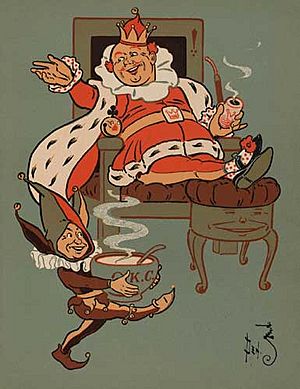Old King Cole facts for kids
Quick facts for kids "Old King Cole" |
|
|---|---|

Illustration by William Wallace Denslow
|
|
| Nursery rhyme | |
| Published | 1708-9 |
"Old King Cole" is a famous British nursery rhyme. It was first written down in 1708. People have wondered for a long time who King Cole was. However, it's very hard to know if he was a real person. The rhyme tells the story of a happy king. He asks for his pipe, his bowl, and his musicians. The exact words can change a little in different versions.
The "bowl" is a cup for drinking. The "pipe" might be a musical instrument or a pipe for smoking.
Contents
Lyrics of Old King Cole
The most common way we sing the rhyme today is:
Old King Cole was a merry old soul,
And a merry old soul was he;
He called for his pipe, and he called for his bowl,
And he called for his fiddlers three.
Every fiddler he had a fiddle,
And a very fine fiddle had he;
Oh there's none so rare, as can compare,
With King Cole and his fiddlers three.
The song first appeared in a book by William King around 1708 or 1709.
King's original version had slightly different words:
Good King Cole,
And he call'd for his Bowle,
And he call'd for Fidler's three;
And there was Fiddle, Fiddle,
And twice Fiddle, Fiddle,
For 'twas my Lady's Birth-day,
Therefore we keep Holy-day
And come to be merry.
Who Was King Cole?
Many people wonder who Old King Cole really was. But it's tough to know for sure. The rhyme is hundreds of years old. So, it's hard to connect it to any real person from history. None of the ideas about his identity are strongly proven.
William King suggested two possibilities. One was a "Prince that Built Colchester." The other was a cloth merchant named Cole-brook from Reading in the 1100s. Sir Walter Scott thought "Auld King Coul" might be Cumhall. He was the father of the giant Fyn M'Coule (Finn McCool). Some people also suggest Richard Cole (1568–1614). He lived in Devon, England.
The Coel Hen Theory
The name of a legendary Welsh king, Coel Hen, sounds like 'Old King Cole'. This makes some people think he might be the king in the rhyme. Coel Hen lived in Roman Britain. However, there's no proof that these ancient figures are linked to the rhyme from the 1700s.
Some people also connect Old King Cole to Colchester. But Colchester was not actually named after Coel Hen. Interestingly, a writer from the 1100s, Geoffrey of Monmouth, said that Coel Hen had a daughter who was good at music. This fits with the musical theme of the nursery rhyme.
A legend says that King Coel of Colchester was the father of Empress Saint Helena. This would make him the grandfather of Constantine the Great. This story appeared in books by Henry of Huntingdon and Geoffrey of Monmouth.
The Cole-brook Theory
In the 1800s, William Chappell studied popular music. He thought "Old King Cole" might be "Old Cole." This was another name for Thomas Cole-brook. He was a cloth merchant from Reading in the 1100s. His story was told in a book around 1598. He was also a character in plays in the early 1600s. The name "Old Cole" was special in plays from that time. But we don't know exactly what it meant.
Old King Cole in Modern Times
King Cole is often mentioned in popular culture today.
In Art
The artist Maxfield Parrish painted a large picture called Old King Cole in 1894. It was sold for a lot of money. Parrish painted another Old King Cole in 1906 for a hotel. This painting is now in the St. Regis New York hotel. It is the main artwork in their King Cole Bar.
As a Marching Song
The United States military has used parts of the rhyme as marching songs. They have done this since at least the 1920s and still do today.
In Music
The band Genesis used "Old King Cole" in their song "The Musical Box". This song is on their 1971 album Nursery Cryme. The album title itself was inspired by the nursery rhyme.
In Stories and Cartoons
In 1897, L. Frank Baum wrote a story about the rhyme. In his version, Cole was a regular person. He was chosen by chance to become king when the old king died without an heir.
James Joyce mentioned the rhyme in his book Finnegans Wake. He played with the words "pipe," "bowl," and "fiddlers three."
The Old King Cole theme appeared in two cartoons in 1933. Walt Disney made a Silly Symphony cartoon called "Old King Cole". In it, King Cole throws a big party for other nursery rhyme characters. Walter Lantz made an Oswald cartoon called The Merry Old Soul. This title also refers to the rhyme.
The Three Stooges made a short film in 1948 called "Fiddlers Three". Larry, Moe, and Shemp play musicians in King Cole's court. They have to stop a bad wizard from taking the king's daughter.
In the Fables comic book series, King Cole was the mayor of Fabletown for a long time.
In Jokes and Satire
In Great Britain, sometimes "Old King Coal" is used in political cartoons. This is a play on words to represent the coal industry.

